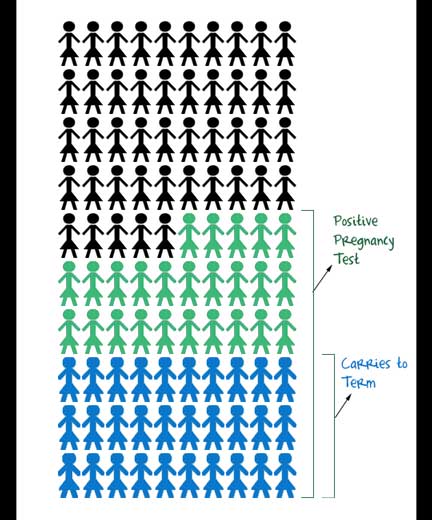Today was my pre-transfer ultrasound. A big day, and also the first point in this journey where things can go horribly wrong. Lucky for me, we leapt over this first hurdle cleanly. Yippee!
This entire process is one big game of statistics. I’ll explain with a bit of data.
Let’s say 100 women start the process of a frozen transfer, just like me. The first hurdle is getting through the pre-transfer ultrasound. Your lining has to be at least 7mm and your ovaries have to be “quiet” — they can’t be hatching an egg or have already hatched an egg. (My lining today was 11mm and my ovaries were fast asleep — yay!) I’m just taking a guess here, but let’s say about 60 of those 100 women make it through this stage.
The next step is all about the embryos. Pronuclear embryos, of which I have two, must first survive the thaw and then survive culturing for five days. Blastocyst embryos (I have two of those also) just have to survive the thaw, and if they do, they can go in the uterus. But there are odds for each type of embryo’s thaw and culture survival rate.
Pronuclear Embryos
Survive the thawing process:
8 out of 10
Survive culturing to five days old:
About 4 out of 10
Blastocyst Embryos
Survive the thawing process:
About 6.5 out of 10
(There is no culturing for blastocysts; they are already 5 days old)
If I was smarter, I could figure out how many of those 60 women would actually get to move ahead with their embryo transfer. (Someone who is better at math figure this out, okay?)
What does this mean? Basically, there’s no guarantee that having four embryos on ice means we’ll have one good one to transfer. We could win the statistical lottery… or lose it and end up with nothing.
But many more statistics are at play here. After the transfer is the pregnancy test. On average, about 55% of women my age have a positive pregnancy test result from a frozen transfer. Beyond the pregnancy test, you have to maintain the pregnancy without miscarrying. If you cross that hurdle, there are the odds of a successful live birth.
Pregnancy Test Positives from FETs & Live Birth Rates from FETs,
Maternal Age <35
Take these all together, and you can see why it’s hard to stay positive. I have trouble believing that I will be lucky enough to be in the “best case scenario” part of each little chart.
Am I that lucky? And since we got Peanut, could I possibly be that lucky again?
This whole process is terrifying. I go back and forth between nervous excitement, and total despair when I think about how far we have to go before we can stop worrying so much. And we might very well find ourselves back at square one if things don’t go well at any of these steps. Urgh.
What it comes down to is this: I have control over so little in this situation. I have to take control of the anxiety and commit myself to what I can change in this situation. And accept what I cannot.
I can control whether or not I take my Estrace on schedule 3 times a day, and my thyroid medicine once a day. (After research found a tie between high Thyroid Stimulating Hormone and IVF success, my clinic started prescribing it to any patients with a wonky TSH; mine was low, so thyroid medicine I shall take.) I will control taking my PIO shots every night on schedule when I start them in two days. I will control my state of mind, and how well I take care of my body between now and the pregnancy test.
On the other hand, I cannot control how fluffy my lining is (luckily, that hurdle’s already jumped!). I cannot control how well my embryos thaw and culture. I can’t control whether or not the embryo snuggles into that fluffy lining and sets up camp for 38 weeks. I’ll do what I can to facilitate that, but ultimately, it’s out of my hands.



0 Comments